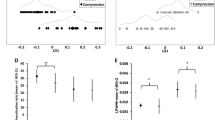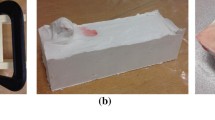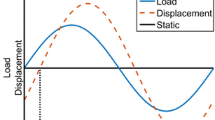Abstract
Bone geometry and tissue material properties jointly govern whole-bone structural behavior. While the role of geometry in structural behavior is well characterized, the contribution of the tissue material properties is less clear, partially due to the multiple tissue constituents and hierarchical levels at which these properties can be characterized. Our objective was to elucidate the contribution of the mineral phase to bone mechanical properties across multiple length scales, from the tissue material level to the structural level. Vitamin D and calcium deficiency in 6-week-old male rats was employed as a model of reduced mineral content with minimal collagen changes. The structural properties of the humeri were measured in three-point bending and related to the mineral content and geometry from microcomputed tomography. Whole-cortex and local bone tissue properties were examined with infrared (IR) spectroscopy, Raman spectroscopy, and nanoindentation to understand the role of altered mineral content on the constituent material behavior. Structural stiffness (−47%) and strength (−50%) were reduced in vitamin D-deficient (−D) humeri relative to controls. Moment of inertia (−38%), tissue mineral density (TMD, −9%), periosteal mineralization (−28%), and IR mineral:matrix ratio (−19%) were reduced in −D cortices. Thus, both decreased tissue mineral content and changes in cortical geometry contributed to impaired skeletal load-bearing function. In fact, 97% of the variability in humeral strength was explained by moment of inertia, TMD, and IR mineral:matrix ratio. The strong relationships between structural properties and cortical material composition demonstrate a critical role of the microscale material behavior in skeletal load-bearing performance.




Similar content being viewed by others
References
van der Meulen MC, Jepsen KJ, Mikic B (2001) Understanding bone strength: size isn’t everything. Bone 29:101–104
Boivin GY, Chavassieux PM, Santora AC, Yates J, Meunier PJ (2000) Alendronate increases bone strength by increasing the mean degree of mineralization of bone tissue in osteoporotic women. Bone 27:687–694
Nuzzo S, Peyrin F, Cloetens P, Baruchel J, Boivin G (2002) Quantification of the degree of mineralization of bone in three dimensions using synchrotron radiation microtomography. Med Phys 29:2672–2681
Paschalis EP, Betts F, DiCarlo E, Mendelsohn R, Boskey AL (1997) FTIR microspectroscopic analysis of human iliac crest biopsies from untreated osteoporotic bone. Calcif Tissue Int 61:487–492
Paschalis EP, Betts F, DiCarlo E, Mendelsohn R, Boskey AL (1997) FTIR microspectroscopic analysis of normal human cortical and trabecular bone. Calcif Tissue Int 61:480–486
Paschalis EP, DiCarlo E, Betts F, Sherman P, Mendelsohn R, Boskey AL (1996) FTIR microspectroscopic analysis of human osteonal bone. Calcif Tissue Int 59:480–487
Jepsen KJ, Schaffler MB, Kuhn JL, Goulet RW, Bonadio J, Goldstein SA (1997) Type I collagen mutation alters the strength and fatigue behavior of Mov13 cortical tissue. J Biomech 30:1141–1147
Silva MJ, Brodt MD, Fan Z, Rho JY (2004) Nanoindentation and whole-bone bending estimates of material properties in bones from the senescence accelerated mouse SAMP6. J Biomech 37:1639–1646
Boskey A, Mendelsohn R (2005) Infrared analysis of bone in health and disease. J Biomed Opt 10:031102
Faibish D, Ott SM, Boskey AL (2006) Mineral changes in osteoporosis: a review. Clin Orthop Relat Res 443:28–38
Bourne BC, van der Meulen MC (2004) Finite element models predict cancellous apparent modulus when tissue modulus is scaled from specimen CT-attenuation. J Biomech 37:613–621
Jaasma MJ, Bayraktar HH, Niebur GL, Keaveny TM (2002) Biomechanical effects of intraspecimen variations in tissue modulus for trabecular bone. J Biomech 35:237–246
Currey JD (1988) The effect of porosity and mineral content on the Young’s modulus of elasticity of compact bone. J Biomech 21:131–139
Burstein AH, Zika JM, Heiple KG, Klein L (1975) Contribution of collagen and mineral to the elastic-plastic properties of bone. J Bone Joint Surg Am 57:956–961
Akkus O, Adar F, Schaffler MB (2004) Age-related changes in physicochemical properties of mineral crystals are related to impaired mechanical function of cortical bone. Bone 34:443–453
Hengsberger S, Ammann P, Legros B, Rizzoli R, Zysset P (2005) Intrinsic bone tissue properties in adult rat vertebrae: modulation by dietary protein. Bone 36:134–141
Brennan TC, Rizzoli R, Ammann P (2009) Selective modification of bone quality by PTH, pamidronate, or raloxifene. J Bone Miner Res 24:800–808
Baylink D, Stauffer M, Wergedal J, Rich C (1970) Formation, mineralization, and resorption of bone in vitamin D-deficient rats. J Clin Invest 49:1122–1134
Donnelly R, Bockman R, DiCarlo E, Betts F, Boskey A (1993) The effect of gallium nitrate on healing of vitamin D- and phosphate-deficient rickets in the immature rat. Calcif Tissue Int 53:400–410
Einhorn TA, Bonnarens F, Burstein AH (1986) The contributions of dietary protein and mineral to the healing of experimental fractures. A biomechanical study. J Bone Joint Surg Am 68:1389–1395
Bielaczyc AR, Golebiewska M, Citko A, Rogowski F (1997) Concentration of the cross-linked carboxyterminal telopeptide of type I collagen in serum of young growing rats fed a low calcium and vitamin D-deficient diet. Eur J Clin Chem Clin Biochem 35:915–918
Kaastad TS, Reikeras O, Halvorsen V, Falch JA, Obrant KJ, Nordsletten L (2001) Vitamin D deficiency and ovariectomy reduced the strength of the femoral neck in rats. Calcif Tissue Int 69:102–108
Pansini AR, Christakos S (1984) Vitamin D-dependent calcium-binding protein in rat kidney. Purification and physiocochemical and immunological characterization. J Biol Chem 259:9735–9741
Jepsen KJ, Goldstein SA, Kuhn JL, Schaffler MB, Bonadio J (1996) Type-I collagen mutation compromises the post-yield behavior of Mov13 long bone. J Orthop Res 14:493–499
Torzilli PA, Takebe K, Burstein AH, Heiple KG (1981) Structural properties of immature canine bone. J Biomech Eng 103:232–238
Young WC (1989) Roark’s formulas for stress and strain. McGraw-Hill, New York
Fritton JC, Myers ER, Wright TM, van der Meulen MC (2005) Loading induces site-specific increases in mineral content assessed by microcomputed tomography of the mouse tibia. Bone 36:1030–1038
Otsu N (1979) A threshold selection method from gray-level histograms. IEEE Trans Syst Man Cybernet SMC 9:62–66
Carter DR, Caler WE, Spengler DM, Frankel VH (1981) Fatigue behavior of adult cortical bone: the influence of mean strain and strain range. Acta Orthop Scand 52:481–490
Cullity BD, Stock SR (2001) Elements of X-ray diffraction. Prentice-Hall, Upper Saddle River, NJ
Faibish D, Gomes A, Boivin G, Binderman I, Boskey A (2005) Infrared imaging of calcified tissue in bone biopsies from adults with osteomalacia. Bone 36:6–12
Donnelly E, Baker SP, Boskey AL, van der Meulen MCH (2006) Effects of surface roughness and maximum load on the mechanical properties of cancellous bone measured by nanoindentation. J Biomed Mater Res A 77:426–435
Donnelly E, Boskey AL, Baker SP, van der Meulen MC (2010) Effects of tissue age on bone tissue material composition and nanomechanical properties in the rat cortex. J Biomed Mater Res A 92:1048–1056
Oliver WC, Pharr GM (1992) Improved technique for determining hardness and elastic modulus using load and displacement sensing indentation experiments. J Mater Res 7:1564–1583
Kazanci M, Wagner HD, Manjubala NI, Gupta HS, Paschalis E, Roschger P, Fratzl P (2007) Raman imaging of two orthogonal planes within cortical bone. Bone 41:456–461
Donnelly E, Williams RM, Downs SA, Dickinson ME, Baker SP, van der Meulen MCH (2006) Quasistatic and dynamic nanomechanical properties of cancellous bone tissue relate to collagen content and organization. J Mater Res 21:2106–2117
Williams RM, Zipfel WR, Webb WW (2005) Interpreting second-harmonic generation images of collagen I fibrils. Biophys J 88:1377–1386
Zipfel WR, Williams RM, Webb WW (2003) Nonlinear magic: multiphoton microscopy in the biosciences. Nat Biotechnol 21:1369–1377
Weinstein RS, Underwood JL, Hutson MS, DeLuca HF (1984) Bone histomorphometry in vitamin D-deficient rats infused with calcium and phosphorus. Am J Physiol Endocrinol Metab 246:E499–E505
Stauffer M, Baylink D, Wergedal J, Rich C (1973) Decreased bone formation, mineralization, and enhanced resorption in calcium-deficient rats. Am J Physiol 225:269–276
Amling M, Priemel M, Holzmann T, Chapin K, Rueger JM, Baron R, Demay MB (1999) Rescue of the skeletal phenotype of vitamin D receptor-ablated mice in the setting of normal mineral ion homeostasis: formal histomorphometric and biomechanical analyses. Endocrinology 140:4982–4987
Brommage R, DeLuca HF (1984) Vitamin D-deficient rats produce reduced quantities of a nutritionally adequate milk. Am J Physiol Endocrinol Metab 246:E221–E226
Weinstein RS, Wan C, Liu Q, Wang Y, Almeida M, O’Brien CA, Thostenson J, Roberson PK, Boskey AL, Clemens TL, Manolagas SC (2010) Endogenous glucocorticoids decrease skeletal angiogenesis, vascularity, hydration, and strength in aged mice. Aging Cell 9:147–161
Acknowledgment
We thank Dr. Stephen Doty and Jeanane Diouri for assistance with tissue processing and histology, Dr. Jacqueline Cole for assistance with mechanical testing and statistical analyses, Dr. Sylvia Christakos for advice on the study design, Hayat Taleb for X-ray diffraction and infrared spectroscopic analyses, and Dr. Junghyun Cho and Andy Zhang for help with nanoindentation. Funding was provided by the Cornell Center for Materials Research (NSF DMR 0520404), the National Institutes of Health (R01 AR053571, P30 AR046121), and the American Association of University Women Educational Foundation (Selected Professions Fellowship).
Author information
Authors and Affiliations
Corresponding author
Additional information
The first two authors contributed equally to this study.
The authors have stated that they have no conflict of interest.
Rights and permissions
About this article
Cite this article
Donnelly, E., Chen, D.X., Boskey, A.L. et al. Contribution of Mineral to Bone Structural Behavior and Tissue Mechanical Properties. Calcif Tissue Int 87, 450–460 (2010). https://doi.org/10.1007/s00223-010-9404-x
Received:
Accepted:
Published:
Issue Date:
DOI: https://doi.org/10.1007/s00223-010-9404-x




